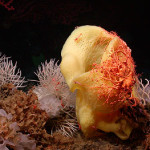That is the common theme in marine biology. Clara Moskowitz has an article up at LiveScience describing how scientists are struggling to keep up with marine life discoveries. Here is a short snippet:
“Scientists figure there are at least 1 million species of marine organisms on Earth.
Of these, only about 230,000 are known to science now, and some of those have more than one name. To keep them all straight, 55 researchers from 17 countries are working on a new list, the ultimate tally of sea creatures great and small.
The list is about half done, the team announced today. So far, the scientists have counted 122,500 species, which puts them about halfway toward completing the inventory of known marine species by their goal of October 2010.
“Describing species without a universal register in place is like setting up a library without an index catalog,” said Philippe Bouchet, a scientist at the French National Museum of Natural History who is helping to compile the list. “
Much of the problem has to do with synonymy, a case when a species has more than one name. This happens for a variety of reasons. For instance, when a taxonomist describes and names a new species without consulting the full history of literature, two taxonomists describe the species around the same time independently, or the literature on a species is difficult to obtain or in obscure local journals. So far, the winner for most names is the “Breadcrumb Sponge”, Halichondria panicea, described as
“the marine world’s reigning champion of Latin aliases, with 56 synonyms appearing in taxonomic literature since its first description in 1766. Of no fixed address, it’s known to frequent floats, pilings, and the underside of rocks, smells like exploded gunpowder and takes on many guises.”
Cleaning up this mess is serious business. With over 250 years of species discoveries to sift through, scientists need a complete record of the literature to accomplish this task. In my opinion, much of the problem lies in obscurity of taxonomic works. Many scientists choose to publish their work in small local museum or society journals that most people wouldn’t know existed or are very difficult to get ahold of.
Open Access (OA) Taxonomy will alleviate much of this problem. The sooner we move to OA Taxonomy, the sooner we can start to keep better track of whats out there, the sooner everyone around the world with an internet connection can be on the same page.
See also the World Register of Marine Species.






This sort of work sounds very interesting, actually.
And somewhat reassuring in that there’s going to be something to do when I’m done my studies.
Nico, no shortage of work to be done! Unfortunately, there is a shortage of funding. I think it will start to get better soon but marine sciences has been in a lull for funding right now (in certain areas anyways). For taxonomy, the situation is worse. If you want to do taxonomy or systematics, you should get some other marketable skills along the way (especially computer skills and genetics). Many scientists, including myself, are optimistic about its future. That is why I work hard to make taxonomy relevant to people’s lives and to other fields of study like medicine and ecology.
Hey Kevin,
Open Access is a step, but I still think you are overlooking the need for training and supporting more systematists and taxonomists. Universities don’t like to train em’ and positions for people doing this kind of work..just aren’t supported outside of museums.
Its getting a little better for people outside of the US. South America and Australia seem to be producing the new crop of global specialists..
hmm…I should write about this…
I certainly agree Chris. But in order to justify more training, we are forced to justify our field. Making taxonomy more relevant to people and other fields of science increases the visibility and stature of the field. Hopefully, this creates a demand for the services of the field, especially in biodiversity studies.
If there is a demand for a field, the university will hire faculty. The universities do not care what fields they hire, they only want faculty that bring in grant money. Unfortunately, taxonomy doesn’t really take much to do. Collecting can be expensive, but looking at an organism under the scope and describing its anatomy is not a financially consuming endeavor.
I view OA as a step in bettering the field and *hope* that better opportunities for taxonomists arise as a result. But training is a serious issue. Not just in a taxon of choice but in the methodology, philosophy and history.
Got the comp skills, and after my intro taxonomy and genetics lectures, I’ll definitely be taking more indepth classes for sure.
I’m only second year marine science, so I have a long way yet, but I am quite excited for fall term to get started.
Some years ago NSF had a program to convert biologists trained in other areas into systematics. I received a grant application to review. The application was good, but I dithered around for a while, and then called the section head at NSF and told him I could not in good conscience review the application. That I thought, given the dearth of systematic jobs, the program itself could not be justified.
I’ve now been retired for ten years and would love to know the ratio of available systematic jobs to searching systematists. What do you think?
I am guessing that was the (Partnerships for Enhancing Expertise in Taxonomy) PEET program. I do know several successful graduate students who have gone to get jobs that were funded by the program. A postdoc in my lab right now was a PEET recipient.
This assessment was written in 2004 (available at ScienceCareers online)
Tracking the PEET trainees is a tough nut. My own PEET had two primary trainees, both PhD and both of whom have jobs, one tenure-track and one with potential to convert to tenure-track. Monographic projects were at the core of their dissertations and both received thorough foundation training in systematics. However, over the objections of some I allowed and encouraged them to take time for other projects that would broaden their credentials. I am convinced that this was key to them getting academic positions for which systematics was not a focus; in fact, other experience with marine invertebrates was higher priority. This is the stealth approach to bringing into academia not only systematics, but a deep understanding of comparative biology so lacking and needed among the more favored biological disciplines. I have every confidence that both will be passing along their PEET training to all of their students, some of whom are likely to take on systematic projects. One of the great things about the PEET project was that it allowed me to slipstream additional trainees into parts of our work with minimal added cost but with huge benefits to their projects. Nevertheless, these indirect beneficiaries have been less definitively successful to date, but most are still in the game.
Hi Jon, thanks for your comment! Its good to have your perspective here as part of the PEET program. Advice I have received from several professors, both within and outside of systematics, has been to get a marketable skill set in something else and do systematics on the side. I am glad your trainees are successful! We need more wormy folk in the US.
I still don’t understand the mindset of funding agencies and academia that view knowing something about species as important, but fail to secure the future for future systematics. Defining, describing, identifying and hypothesizing the evolutionary relationships of species is so fundamental to nearly all of biology, yet it is still ignorantly viewed as a non-science. But how much does agriculture, medicine and conservation rely on proper identification and description of species? Everything depends on knowing what you are studying! Systematics is a hypothesis driven science at its foundation. People in the field need to do a better job at explaining the importance to the general public. Which is why I have been outlining a potential center or non-profit for applied taxonomy. A solution and service oriented institute to improve taxonomic knowledge about species of concern to government and industry, including pharmaceutical/medicinal, biodiversity/conservation, and agricultural/aquacultural. Its not well-formulated, but is a dream of mine. The mission includes significant outreach to the public to explain the importance of taxonomy to everyday people’s lives from a variety of viewpoints.